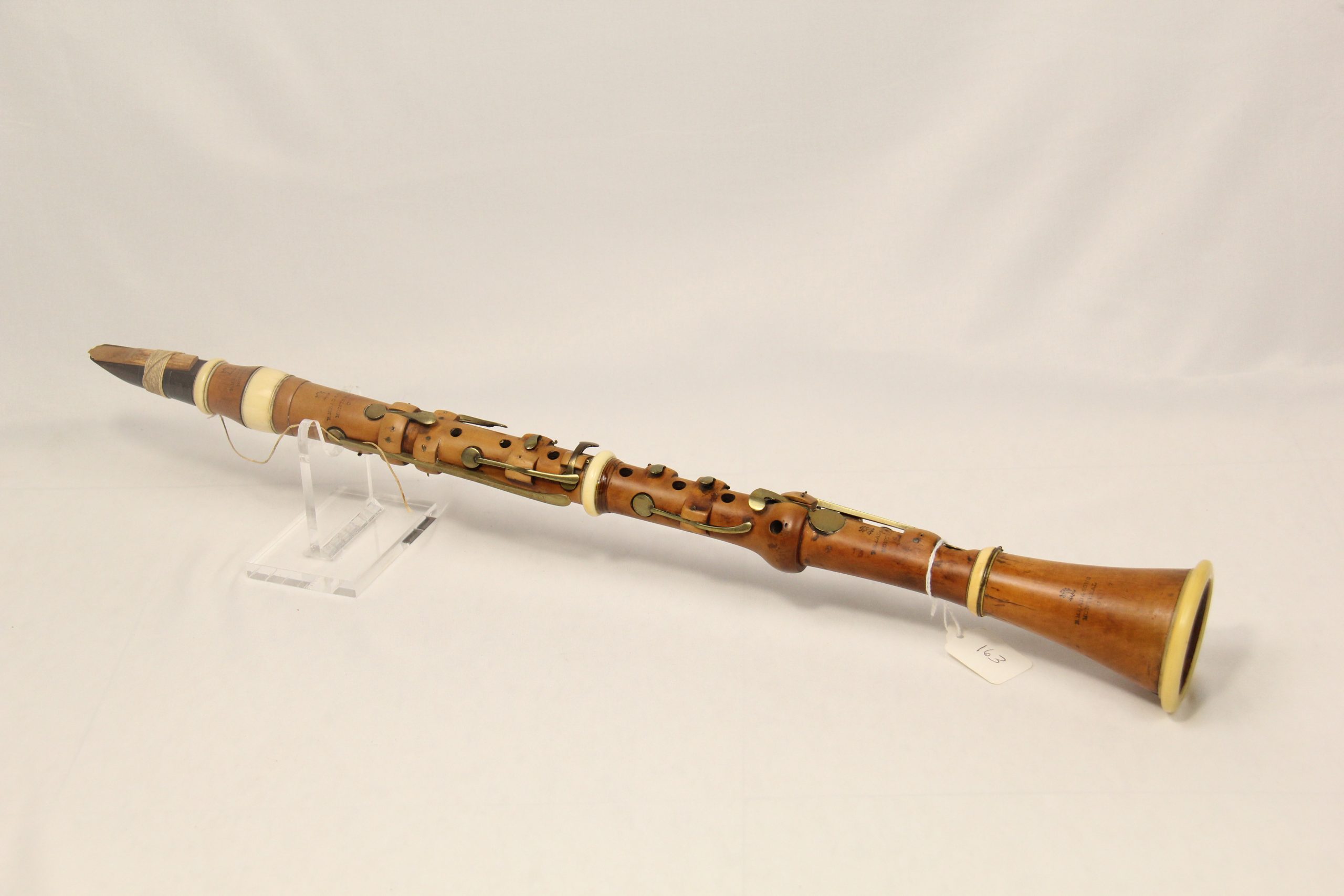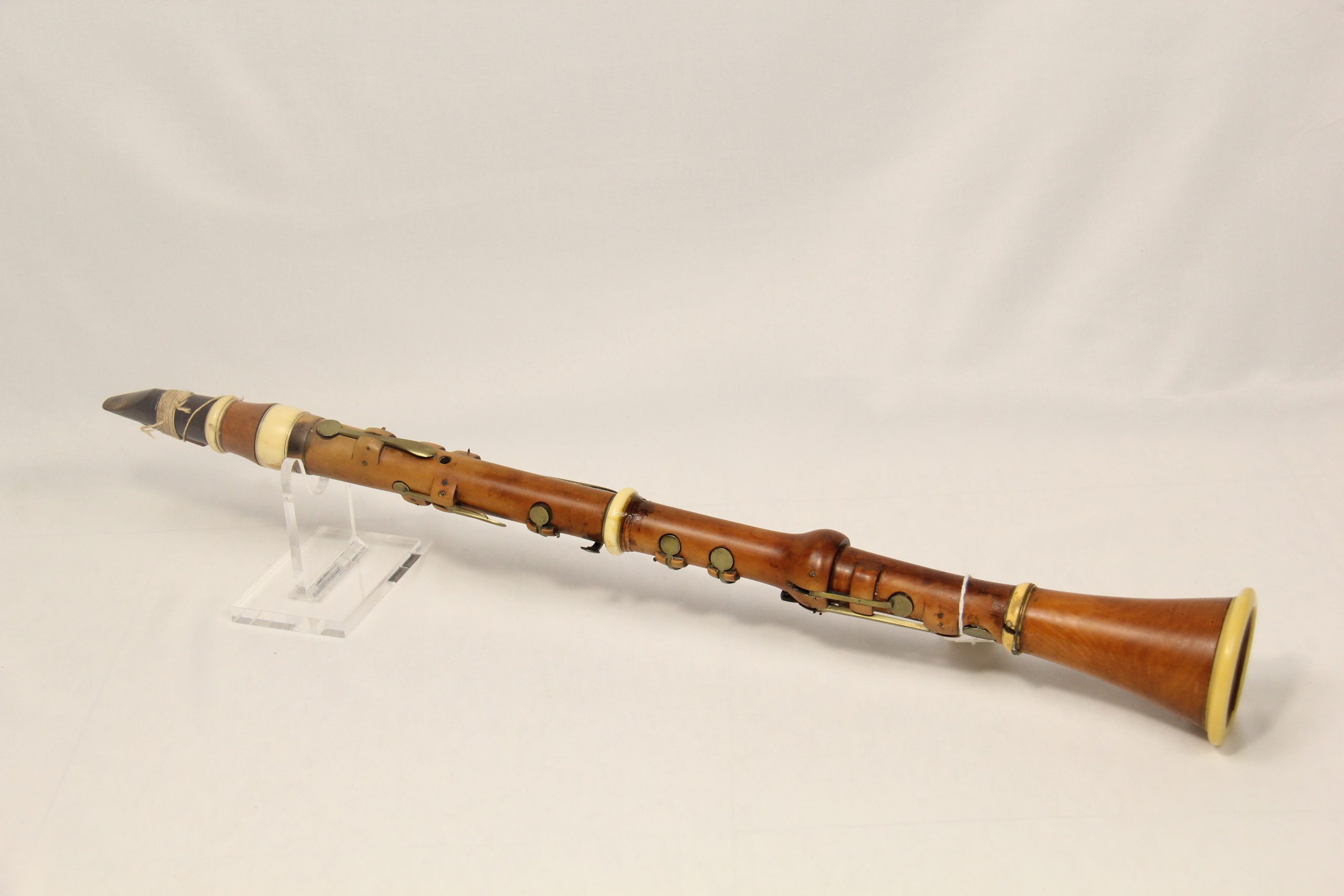Clarinet in C
Details
- Origin: Montreal, Canada
- Date: c. 1840-50
- Maker: R. Mead & Sons
- Collection: E 163
Description
Wooden clarinet, boxwood with ivory ferrules, also constructed with brass, ivory, cork, string and reed. 13, flat round, brass keys in block mounts, except lowest three in bulge mount. Lion or dog icon, and “R. Mead & Sons/Montreal/C” stamped on barrel, upper, lower joints and bell.
This instrument utilizes the thirteen-key system – the name of this system, invented by German clarinetist and basset-horn player Iwan Müller, came to be known as the “simple” system. Iwan Müller pioneered the use of stuffed pads over counter-sunk tone holes, and invented the metal ligature in 1817. For another example of a 13-key clarinet, see our Clarinet in A (E 182).
Some of the most important musical developments for the clarinet occurred between 1760 and 1830.
“First, there evolved the classical and early-romantic styles of composition; second, a modern orchestral idiom appeared; and third, composers, players, and makers cultivated the technical and tonal capabilities of the clarinet. Outstanding individual performers often served as an impetus to the musical imagination of composers, such as Gaspard Proksch and Johann Stamitz; Josef Beer and Carl Stamitz; Anton Stadler and Mozart; Johann Hermstedt and Spohr; Heinrich Baermann and Weber; and Josef Bähr or Joseph Friedlowsky and Beethoven. In turn, makers and players contributed additional keys, design modifications, and construction changes to the clarinet.” [4]
Regarding the performance history of clarinets in early 19th century classical music, Carl Maria von Weber’s clarinet Concertino, and First and Second Concertos were very significant. These concertos were written for Heinrich Baermann, who played ten- and later twelve-key clarinets. Following von Weber, at least three composers wrote concertos specifically for Müller’s thirteen-key clarinet. (Reicha in 1815; G. A. Schneider in 1816; and Riotte in 1818).
See von Weber’s Clarinet Concertos Nos. 1 and 2: https://open.spotify.com/album/102tJj2Q8SqX844qwCMvc5?si=LVti5vaBSAOZpwaCXznYvA
See Anton Reicha’s Clarinet Concerto in G-minor (1815):
https://open.spotify.com/album/7vVQ39DlQ0UCaRrkCsUdJT?si=kKBpqBp8RUSs_wfybRvw9
Victorian Age music in Canada paralleled basic European style periods “from the baroque to the classical, romantic, and contemporary” [2]. Classical programs included band overtures, piano solos, national songs and choral pieces, as well as oratorio performances and operas. Canadian opera performances primarily relied on visiting troupes. Such groups performed at opera houses all over Canada, with Toronto’s Massey Hall (1894) being very notable.

Sources
“Müller, Iwan.” Grove Music Online. Accessed June 15, 2022. https://www.oxfordmusiconline.com/grovemusic/view/10.1093/gmo/9781561592630.001.0001/omo-9781561592630-e-0000019320?rskey=Woe0bw.
“Music History.” The Canadian Encyclopedia. Accessed June 15, 2022. https://www.thecanadianencyclopedia.ca/en/article/music-history.
Toronto Public Library. “Remembering Massey Hall: June 14: Snapshots in History.” Local History & Genealogy. Accessed June 15, 2022. https://torontopubliclibrary.typepad.com/local-history-genealogy/2016/06/remembering-massey-hall-june-14-snapshots-in-history.html.
Rice, Albert R. The Clarinet in the Classical Period. Oxford: Oxford Univ. Press, 2011.







